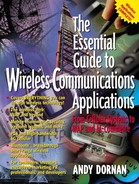Duplexing
A single communications channel can only be used to transmit information one way, as in a broadcast radio or TV station. Simple two-way radios use the same channel for both, but require the radio to stop receiving information when it is transmitting—the user holds down a switch while talking, then releases it to listen for a reply. True two-way or duplex communication requires two channels.
FDD
Frequency Division Duplex (FDD) uses two separate frequency bands, meaning that the mobile terminal is transmitting on one frequency while receiving on another. The frequency at which the base station transmits is called the downlink, and the frequency at which the mobile terminal transmits is called the uplink. Satellite systems often have an optional uplink, meaning they can be used for either one-way or two-way communication.
Most cellular systems use FDD, so many governments actually grant licenses in pairs: one slice of spectrum for the uplink and another for the downlink. This is known as paired spectrum. The pairs are usually equal in size, meaning the communications channel is symmetric: the same amount of information can be transmitted to the mobile phone as from it. This is ideal for voice links, but not for many Internet applications. Web surfing is inherently asymmetric: users download Web pages and graphics, but upload only mouse clicks. A symmetric connection to the Web wastes most of its bandwidth, though can be useful for other applications, notably email. Users who frequently send file attachments while mobile will appreciate all the upstream bandwidth they can get.
Spectrum pairs always use the higher frequency for the downlink and the lower one for the uplink. This is because high frequencies have a slightly shorter range, and the base station can increase its transmission power to compensate. Mobile terminals can transmit using slightly lower power, which lengthens battery life and reduces the risk of radiation harming the user.
TDD
Time Division Duplex (TDD) uses only one channel, but alternates between transmitting and listening—essentially a faster, automated version of the switch-to-transmit system. Its great advantage is that bandwidth can be allocated dynamically between the uplink and the downlink, allowing asymmetric data links. The distinction between the two can also be eliminated entirely in a peer-to-peer network, where each node transmits directly to another without using a base station. TDD is common in short-range wireless LAN systems.
